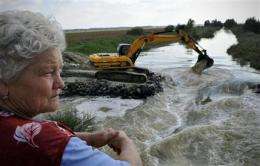Hungary's red sludge nearly equals Gulf oil spill

(AP) -- The mighty Danube apparently absorbed Hungary's massive red sludge spill with little immediate damage Friday but laboratory tests heightened concerns about possible longer-term harm caused by toxic heavy metals in the slurry.
Government officials lowered their estimate of the size of Monday's catastrophic spill - but even those figures were mind-boggling. They said the reservoir break at an alumina plant dumped up to 700,000 cubic meters (184 million gallons) of sludge onto three villages - not much less in a few hours than the 200 million gallons the blown-out BP oil well gushed into the Gulf of Mexico over several months beginning in April.
A fifth person - an 81-year-old man - died Friday from injuries sustained in the torrent, Hungary's rescue service said.
The red sludge devastated creeks and rivers near the spill site and entered the Danube on Thursday, moving downstream toward Hungary's immediate neighbors, Croatia, Serbia and Romania. Monitors were taking samples every few hours Friday to measure damage from the spill but the sheer volume flowing in Europe's second largest river appeared to be blunting the red sludge's immediate impact.
Prime Minister Viktor Orban said the threat to the Danube had been eliminated, and the International Commission for the Protection of the Danube, a Vienna-based group that monitors the river and its tributaries, agreed.
"We managed to take control of the situation in time," the state MTI news agency quoted Orban as saying.
"The consequences do not seem to be that dramatic," said Philip Weller, head of the Danube commission, told The Associated Press.
The pH level of the water where the slurry entered the Danube was 9 - well below the 13.5 measured in local waterways and not too damaging to the environment, Hungarian rescue agency spokesman Tibor Dobson told MTI.
A neutral pH level for water is 7. Each pH number is 10 times the previous level, so a pH of 13 is 1,000 times more alkaline than a pH of 10.
Authorities on Friday restricted media access to Kolontar, the devastated village closest to the leak, claiming reporters and TV crews were interfering with cleanup work. Reporters were assigned minders.
Despite the apparent good news about the Danube, the risk of pervasive and lasting environmental damage remained, with Greenpeace presenting laboratory tests that it said showed high concentrations of heavy metals in the sludge.
Red sludge samples taken Tuesday, a day after the spill, contained "surprisingly high" levels of arsenic and mercury, Greenpeace told reporters in Vienna on Friday. The analysis suggested that roughly 50 tons of arsenic, 300 tons of chrome and half a ton of mercury was unleashed by the spill, Greenpeace officials said.
They said the detected arsenic concentration was twice the amount normally found in so-called red mud, a waste product in aluminum production. Analysis of water in a canal near the spill also found arsenic levels 25 times the limit for drinking water, Greenpeace said.
With rain giving way to dry, warmer weather, the caustic mud was increasingly turning to airborne dust, which can cause respiratory problems, said Zoltan Illes, Hungary's environmental chief. Emergency officials urged residents near the toxic flood area to wear face masks.
The warnings conflicted with the view of the prestigious Hungarian Academy of Sciences, which reiterated Friday that the red sludge remained hazardous due to its caustic alkalinity but its heavy metal concentrations were not considered dangerous for the environment.
"The academy can say whatever it wants," fumed Barbara Szalai Szita, who lives in Devecser, one of the hardest-hit villages. "All I know is that if I spend 30 minutes outside I get a foul taste in my mouth and my tongue feels strange."
Emergency crews, meanwhile, drained a second industrial reservoir at the spill site Friday to prevent a new disaster, while others drained a nearby swollen pond but did not find any of the three people still missing.
Dobson told the AP that 100,000 cubic meters (26 million gallons) of fluid from a storage pond close to the burst reservoir was being gradually released Friday into a local river already declared dead after Monday's environmental catastrophe. Gypsum was being dropped into the Marcal River from helicopters to neutralize the alkaline effect of the fluid, he said.
It is still not known what caused a section of the reservoir to collapse.
However, meteorologists at AccuWeather.com noted that spring and summer rains across eastern Europe were more than 200 percent above normal and said the walls holding back the sludge may have been weakened by the rain.
MAL Rt., the Hungarian Aluminum Production and Trade Company that owns the Ajkai Timfoldgyar plant where the spill occurred has rejected criticism it should have taken more precautions at the reservoir.
Hungarian police have confiscated documents from the company, and the National Investigation Office was looking into whether on-the-job carelessness was a factor in the disaster.
More than 150 victims were treated at hospitals and 10 are still in serious condition.
©2010 The Associated Press. All rights reserved. This material may not be published, broadcast, rewritten or redistributed.





















